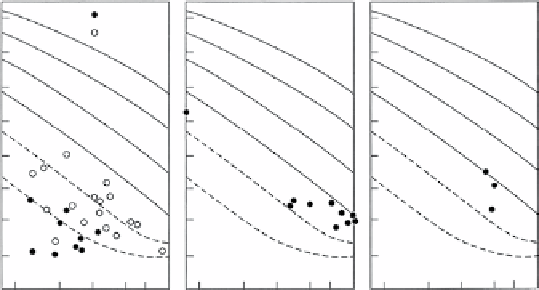Geology Reference
In-Depth Information
Lodranite
5.97 g
Found December 30, 1988
1.5 × 1.5 × 1.1 cm
Weathering = B
isotopic composition with acapulcoites and are believed to have origi-
nated on a common parent body. Lodranites experienced melting and loss
of the silicate component, with peak temperatures of ~1250°C. They
provide our best glimpse of the early melting history of asteroids.
LEW 88 ...
1 cm
A. Lodran
B. LEW 88280
C. Yamato 791491
0.1°C/My
1°
10°
0.1°C/My
1°
10°
0.1°C/My
1°
10°
Our data
Bild and
wasson,1976
45
40
35
100°
100°
100°
30
1000°
1000°
1000°
25
10000°
10000°
10000°
20
15
10
5
4
10 0 060100
4 10 0 060
Distance to nearest edge (
μ
m)
1004
10
20
40 60 100
Plate 42
MiNERALogy
SigNiFiCANCE
LEW 88280 contains a coarse equigranular aggregate
of anhedral to subhedral olivine (Fa
13
) and pyroxene
( Wo
3
Fs
12
) grains, 0.6-1.2 mm across, with about 20% of
intergranular nickel-iron and a little troilite.
LEW 88280 has metal lamellae and compositions indicat-
ing a very rapid cooling rate, as do several other lodranites
and acapulcoites (left, [283]). it has high Feo olivine, and
abundant FeS, and represents one of the highest δ
18
o
lodranites known. All of these qualities make it an
important sample representing one end of the spectrum
of lodranite characteristics. However, it also has a
distinctly older cosmic ray exposure age, so it is possibly
from a different parent body than many other lodranites.
References [278-285]





